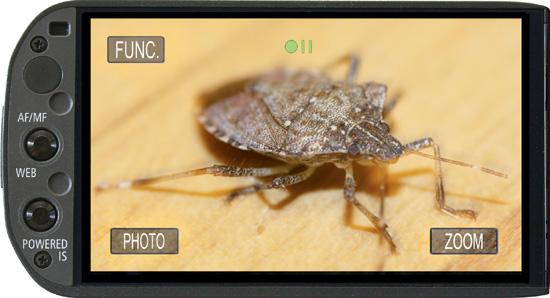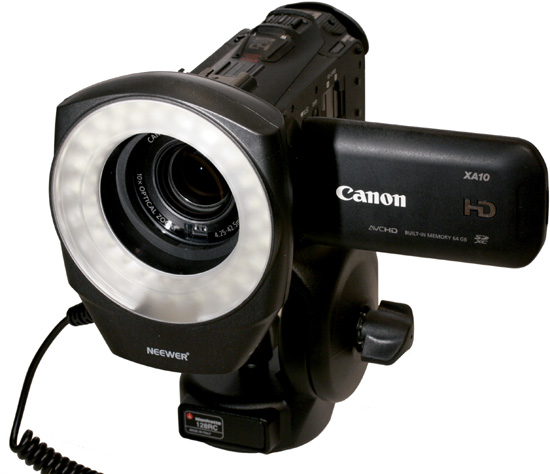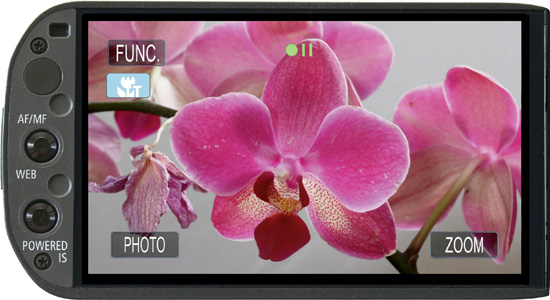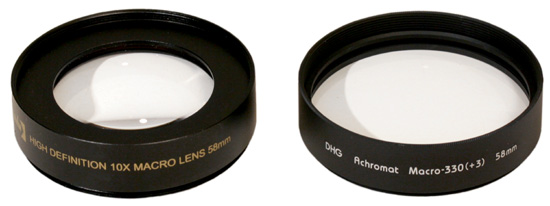14
Extreme Close-Up Videography
Most photographic lenses have a close focusing distance equal to about 20× their focal length. However, a macro lens is capable of focusing much nearer to capture extreme close-ups. The G10/XA10 has some built-in ability to work in close range with a self activated mode called Tele Macro.
By one definition, a macro photo is an image taken in the range of a 1:1 ratio between the size of the subject and the size of the negative or photo sensor. A ratio of 1:1 on a ![]() -inch photo sensor would mean an image the size of a kernel of corn would have to fill the screen, which the G10/XA10 does not even come near achieving. Others define magnifications of 1:1 or greater as the beginning of photomicrography and define macro as the ability of a lens to focus closer than 20× its focal length. By this second definition, the G10/XA10’s ability to extend focus manages to just enter the macro range. If you consider that 20 multiplied by the 42.5mm telephoto focal length equals 850mm (33.4 inches), focusing closer than 33 inches in telephoto (measured from the CMOS chip deep in the camcorder, not from the front of the lens) can be called macro under some definitions.
-inch photo sensor would mean an image the size of a kernel of corn would have to fill the screen, which the G10/XA10 does not even come near achieving. Others define magnifications of 1:1 or greater as the beginning of photomicrography and define macro as the ability of a lens to focus closer than 20× its focal length. By this second definition, the G10/XA10’s ability to extend focus manages to just enter the macro range. If you consider that 20 multiplied by the 42.5mm telephoto focal length equals 850mm (33.4 inches), focusing closer than 33 inches in telephoto (measured from the CMOS chip deep in the camcorder, not from the front of the lens) can be called macro under some definitions.
According to Canon, the camcorder’s normal minimum focus distance in AUTO mode for full telephoto is about 3.3 feet (one meter). The camcorder’s logic system, SMART AUTO, analyzes the subject and the shooting conditions, recognizes when you have exceeded the standard minimum distance while shooting in or near full telephoto, and automatically activates Tele Macro mode. You will know that you have entered Tele Macro mode when you see the AUTO button in the upper-left corner of the touchscreen change into a tulip icon with a letter T, as shown in Figure 14.1.
Figure 14.1 The tulip icon with a letter T indicates Tele Macro mode.
Tele Macro increases the camcorder’s image stabilization and shifts lens elements toward macro position, which provides focus up to approximately 2 feet from the front of the lens and possibly closer under very bright light. (Canon literature says as close as 1.3 feet.) Aside from this ability to focus a few inches closer while in AUTO mode, the principal thing that SMART AUTO does when it enters Tele Macro mode is select the foreground object for focus as opposed to somewhere else in the composition.
Being able to focus at 2 feet instead of 3 feet does not produce a spectacular result, but it does give you some additional extreme close-up capability and allows the full AUTO mode to hold on the foreground subject. Canon’s advertising singles out Tele Macro as a significant feature. However, Tele Macro is basically an assurance that if you shoot in full AUTO mode, SMART AUTO will recognize that an object in telephoto at 2 feet from the lens is an intentional element of the composition and will focus on it. If Canon were serious about providing macro capability on the G10/ XA10, it would have designed an even closer focus range and would have made the feature available in M mode with options for manual controls of focus and exposure.
According to Canon, Tele Macro is available only in full AUTO mode. However, there does not appear to be much difference between letting the lens enter Tele Macro while in full AUTO versus using manual focus in the M mode under Programmed AE or Manual Exposure. With the telephoto lens fully extended, both can focus at about 2 feet, which is a few inches less than 20× the focal length (in other words, slightly into the macro range). Each provides a field size of about ![]() inches in diameter. So if the M mode allows you to get close enough, you may prefer the ability to use manual focus and manual exposure. Working at extremely close distances often requires the precision of manual controls.
inches in diameter. So if the M mode allows you to get close enough, you may prefer the ability to use manual focus and manual exposure. Working at extremely close distances often requires the precision of manual controls.
Auxiliary Lenses
Some may be disappointed with the limited macro ability of the G10/XA10. But an auxiliary close-up lens called a diopter or a reverse-mounted prime lens from a DSLR provide ways of working even closer.
A diopter lens functions identically to a magnifying glass or eyeglasses for reading. The diopter threads onto the front of the camcorder’s zoom lens. It brings close objects into focus and alters the ability of the lens to focus in its normal range. A diopter will allow you to shoot in full AUTO mode, but its real advantage is the potential of having semi-automatic or full manual control in the M mode.
The term “diopter” refers to both an optical measurement and to a magnifying lens that is measured in diopters. A #1 diopter comes into focus at 1 meter away, and would provide a working distance of 1 meter and closer. A #2 diopter comes into focus at ½ meter (about 19.5 inches), a #3 at ![]() meter (about 13 inches), and a #10 at
meter (about 13 inches), and a #10 at ![]() meter (about 4 inches). The closer the focusing distance, the greater the magnification.
meter (about 4 inches). The closer the focusing distance, the greater the magnification.
Single-element diopters are the least expensive way to achieve macro photography. Tiffen (an American manufacturer of filters) and Hoya (a division of Tokina Optical) make single-element diopter lenses that can fit on the front of the camcorder’s zoom lens like a filter. A Tiffen or Hoya set containing three close-up lenses with a 58mm thread size costs from $11 to $20. The three diopters in the set allow for macro photography at seven different working distances, depending on whether they are used individually or in combination.
These diopters permit focusing at close camera-to-subject distances, but single-element lenses cannot optically provide a flat field of focus or edge-to-edge sharpness, and cannot bring all colors into sharp focus on the same plane for professional image quality. Sometimes these defects escape notice because they are obscured in the very shallow depth of field inherent in extreme close-ups. But only a multi-element lens can provide edge-to-edge sharpness and minimize chromatic aberration and distortion.
The 10× High Definition II macro lens from Opteka, shown in Figure 14.2, sells for $19. This is a four-element #10 diopter that is 40mm wide, adapted to fit a 58mm filter thread (the size of the camcorder’s lens). Because this is a smaller-width lens in a 58mm mount, the outer limits of the image become masked in a circle of black in the wider third of the zoom range, but are not affected in mid-range or telephoto. It allows you to focus at a distance of ![]() meter, approximately 4 inches from the lens. Opteka does not claim that the lens is “achromatic,” which means it is probably not sufficiently corrected for chromatic aberration. But it should be an improvement over a single-element diopter if you do not need the full zoom range.
meter, approximately 4 inches from the lens. Opteka does not claim that the lens is “achromatic,” which means it is probably not sufficiently corrected for chromatic aberration. But it should be an improvement over a single-element diopter if you do not need the full zoom range.
Figure 14.2 Multi-element diopter lenses by Opteka and Marumi for macro photography.
For higher image quality in a 58mm diameter, Canon makes the 250D achromatic close-up lens, which sells for $212 to $299. This is considerably more expensive than the $20 Hoya single-element lens or $19 Opteka. Its 58mm thread attaches to the front of the camcorder’s zoom lens and its 250mm focal length changes the camcorder’s maximum focusing distance from infinity to ¼ meter, or 9.9 inches.
Far more affordable is the Marumi 58mm DHG Macro 330 Achromat, also shown in Figure 14.2, which sells for $65. This is a professional quality +3 multi-element achromatic close-up lens made in Japan. It has an anti-reflective coating to minimize reflections that could degrade the image, and like the Canon 250D, it operates as an auxiliary lens that screws onto the front of the zoom. As a +3 diopter, it alters the maximum working distance from infinity to ![]() meter, approximately 13 inches. This provides a little more working distance for lighting the miniature subject
meter, approximately 13 inches. This provides a little more working distance for lighting the miniature subject
Macro photography can also be accomplished by mounting a high-quality prime lens from a still camera to the front of the camcorder’s zoom lens. They are attached to each other with a lens coupler that screws into the filter threads of both lenses, tying them together front-to-front. For example, the Canon 50mm f/1.4 prime lens for a DSLR has a 58mm thread to accommodate a potential filter. (Other DSLR lenses have sizes that range from 49mm to as large as 72mm.) A male-to-male, 58mm-to-58mm lens coupler with threads on each side reverses the DSLR prime lens and mounts it face to face to the 58mm front of the camcorder’s zoom, as shown in Figure 14.3. The camcorder’s lens shade would have to be removed for the zoom lens to accommodate the Canon 50mm prime lens. The two in combination become a high-quality macro system for shooting extreme close-ups with a field size of about ![]() inch.
inch.
Figure 14.3 Canon 50mm f/1.4 prime lens, mounted in reverse.
Shooting in Macro
Macro video opens a different world full of creative and expressive possibilities for the videographer. Extreme close-up becomes a way to evoke an almost tactile sensation through visual means as the video image approaches the 1:1 scale of touch. An otherwise mundane everyday image or action can be defamiliarized when experienced on a macro scale and consequently compel the spectator to freshly see beyond that which is familiar or taken for granted. Defamiliarization is an aesthetic concept that comes from art theorist Viktor Shklovsky and is a central idea in dada, surrealism, formalism, and postmodernism.
In macro, even tiny movements become enormous. Some macro images may need Tv (Time value) Priority programmed mode to set a high shutter speed to minimize motion blur, vibration, and camera shake. Conversely, if the camera is well stabilized and motion blur is not an issue, Av (Aperture value) Priority programmed mode might be set to f/8 to achieve a deeper depth of field to get more of a miniature, three-dimensional object in focus. At normal video working distances, depth of field is measured in feet and focus may extend to infinity at times. At macro distances, depth of field is measured in millimeters and can become so shallow that you have to choose between the head, the wings, or the torso of an insect because the depth of the entire insect cannot be brought into focus. (See Figure 14.4.) Setting the aperture at f/8 will help. Even then, depth of field may be so shallow that you will have to settle for achieving critical focus on only the most important part of your subject.
A camera slider (or at least a tripod) is highly recommended to minimize shake, vibration, and motion blur, which can become enormously exaggerated when working in extreme close-up. A slider can make fluid camera moves when in extreme close-up and can even be used to rack focus by slowly gliding the camera physically closer or further instead of using the focus ring. To prevent jarring the camcorder, you may want to use the wireless remote for triggering the camcorder’s functions.
Figure 14.4 Extremely shallow depth of field is inherent in macro photography.

When you are working very close, the inherently shallow depth of field will soften the background and will help create emphasis on the subject. But sometimes even in soft focus, the background can be too busy, too distracting, or less than ideal for your subject. Working on such a miniature scale, it is sometimes preferable to replace the background with a white, black, light gray, or sky blue card. Being completely out of focus, the card will look natural. It will give you one more element of control over the composition.
Extremely close images sometimes need to be slowed down to amplify time in a manner comparable to the amplification of visual scale. Because the G10/XA10 does not have slow-motion speeds, this can be done in postproduction by re-rendering the video at ½ or ![]() speed in an editing program. In some cases, this may look more natural than standard speed. Sound, too, might be amplified or wholly invented to enhance the macro scale visuals. What is the appropriate Foley sound for ants attending to a queen or a spider wrapping up a fly in threads of web silk?
speed in an editing program. In some cases, this may look more natural than standard speed. Sound, too, might be amplified or wholly invented to enhance the macro scale visuals. What is the appropriate Foley sound for ants attending to a queen or a spider wrapping up a fly in threads of web silk?
Lighting
The main problem with lighting in macro is the short working distance between the subject and the camcorder. LED lights are good solutions because they can be used at close distances, are ideal for small areas, and do not generate heat. LED arrays like Litepanels or the inexpensive Neewer CN128 or CN160 can work as key or fill light. You have to be careful that the proximity of the camcorder’s lens does not cast a shadow on the subject.
If additional fill light needs to come from the front, there are LED ring lights that fit around the lens. The Neewer LED macro ring light sells for $35 and comes with six adapter rings (49mm, 52mm, 55mm, 58mm, 62mm, and 67mm) to fit a variety of lenses. Shown in Figure 14.5, it has a controller to turn on all of its 48 LEDs or just the right or left half. The unit can be powered by two AA batteries or an AC adapter. Ring lights by other manufacturers range in price from $64 for the Bower SFDRLM with 12 LEDs to the Litepanels RM-FT Ringlite Mini System for $2,065, with 72 full tungsten-balanced LEDs on a 10.5-inch ring for large professional lenses. All the LED rings produce a soft, shadowless fill light for macro photography. With only the right or left half illuminated, a ring light can also function as a soft key light.
Figure 14.5 Neewer 48-LED macro ring light.

A small instrument with a single LED point source of illumination is ideal for providing a crisp, hard light in a small area for use as a key or backlight. The Ikan iLED ONE comes with a single 60° high-intensity tungsten-balanced LED bulb. It has a swivel mount that fits on a universal shoe or a ¼-inch thread like a tripod. The Ikan iLED ONE costs approximately $90 if it is purchased with its AC power supply, which provides 12 volts. It is about $220 with a heavy-duty field battery and charger. For an even sharper edged light using the iLED ONE, you can purchase interchangeable LED lamp units for $35 with a narrower, more concentrated 40° tungsten or a 40° daylight bulb.
If you already own the Canon VL-10Li II video light, which normally mounts on the camcorder, this could also serve as a crisp key light or backlight for macro photography. With a shoe adapter, it can be mounted on a lightweight tripod or small stand to provide a suitable angle. The VL-10Li II has a tungsten miniature reflector bulb (MR11), which would balance with any ambient tungsten light hitting the miniature subject.



